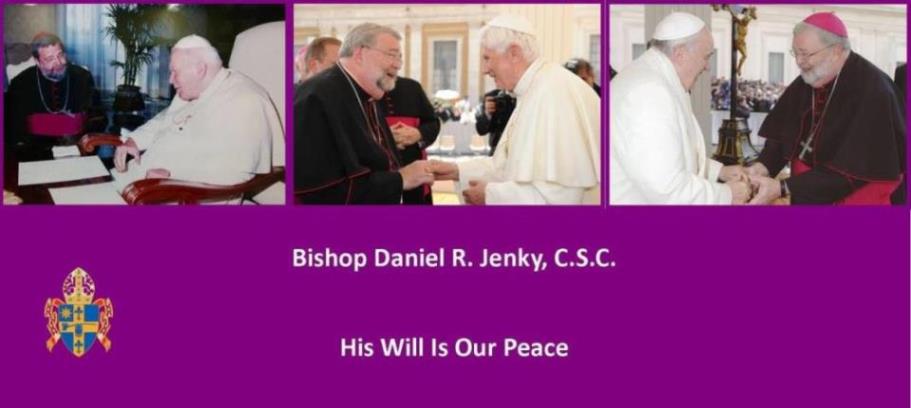 |
| The Cathedra |
Explanation of the Coat of Arms
Blazon
Impaled Arms
On the dexter for the Diocese of Peoria; Azure, on a cross
throughout and in the first quarter a mullet of eight points Or, a calumet
fesswise between two fleurs-de-lis in pale of the field. On the sinister for
Bishop Jenky: per fess Gules and Azure, on a pale indented Or between in dexter
chief a crescent Argent and in sinsiter base two anchors in saltire Argent
surmounted by a Latin cross Or, a seraph Gules nimbed Or.
Motto
"HIS WILL IS OUR PEACE."
Significance
The entire "achievement" or coat of arms as it is
generally called, is composed of a shield with its charges, the motto and
external ornaments. As one looks at the shield, the terms dexter and sinister
must be understood contrariwise, as the shield was worn on the arm in medieval
days, and these terms were used in the relationship of the one behind the
armor.
The dexter impalement, on the left of the viewer, bears,
according to custom in ecclesiastical heraldry, the jurisdictional arms of the
Diocese of Peoria.
The arms consist of a blue field charged with a gold
(yellow) cross of Faith bearing two fleurs-de-lis and a calumet-"peace
pipe" also tinctured blue. In the first quarter is a gold (yellow)
eight-pointed star. The gold cross and two fleur-de-lis honor the French
missionaries who brought the faith to the Indians of the Mississippi Valley.
Gold and blue fleur-de-lis were the colors and charges on the ancient arms of
France. The two fleur-de-lis also commemorate the first missionary, Fr. Jacques
Marquette and his companion, Louis Joliet, who passed through the territory
which is now the Diocese of Peoria in the state of Illinois.
The calumet, the name given by the French to the "peace
pipe" of the American Indians, occupies the traverse member of the cross.
When Fr. Marquette and Joliet made their memorable voyage down the Mississippi
River, the chief of the Peoria, a branch of the Illinois Indians, gave a
calumet to Fr. Marquette. The report of the voyage says about the calumet:
"There is nothing more mysterious or respected among them. Less honor is
paid to crowns and scepters of kings than the savages bestow upon this."
The star in the dexter chief is derived from the coat of arms of LaSalle, who
established Fort Creve Coeur across the river from Peoria in 1680.
The sinister impalement, on the right of the viewer,
displays the personal Arms of Bishop Jenky. By combining the personal Arms on
same shield with those of the Diocese of Peoria the spiritual unity of the
Bishop with his flock is signified, a thought also conveyed by the ring, which
the Bishop wears on his right hand.
The personal Arms of Bishop Jenky consist of a shield
divided "per fess" across the center, the upper portion red and lower
portion blue. Overall is a"pale," or band indebted from the top to
the base of the shield tinctured gold (yellow). The pale is charged with a
seraph (red) with a gold (yellow) nimbus. In the dexter chief is silver (white)
crescent in the sinister base base the charges of the Arms of the Congregation
of the Holy Cross: two silver (white) anchors in saltire surmounted by a Latin
Cross gold (yellow).
The red and blue of the surface of the shield honor the
Sacred Heart of Jesus and the Blessed Virgin Mary. The gold (yellow) indented
"pale" honors the Holy Trinity. The silver (white) crescent and the
red seraph with gold (yellow) nimbus are to be found on the Arms of the Diocese
of Fort Wayne-South Bend in the state of Indiana. These charges honor the
patrons of the Cathedral of the Immaculate Conception in Fort Wayne, and the
Co-Cathedral of St. Matthew in South Bend.
The red upper portion of the Arms and the silver (white) of
the crescent honor the Polish heritage of the family of Bishop Jenky.
It is customary for members of religious orders to display
the Arms, or incorporate the insignia of their order on the personal Arms when
ordained to the Episcopate. This custom has been continued by Bishop Jenky with
the two silver (white) anchors in saltire and gold (yellow) Latin Cross overall
in the sinister base. The emblems on a blue background are the Arms of the Congregation
of the Holy Cross.
The motto, "HIS WILL IS OUR PEACE," is from the
Divine Comedy-Paradiso, Canto 3, line 85, by Dante Alighieri (1265-1321) and
succinctly summarizes the spiritual advice of the prophets and saints from
ancient times.
Behind the Arms is placed a Gold processional cross and
ensigning the whole achievement is a pontifical hat with its six tassels on
each side, disposed in three rows all in green. These are the heraldic insignia
of a prelate of the rank of bishop in accordance with the instruction of the
Holy See, dated 31 March, 1969. Before 1870 the pontifical hat was worn at
solemn cavalcades in conjunction with Papal ceremonies. The color of the hat
and the number of tassels were signs of the rank of the prelate, a custom still
preserved in ecclesiastical heraldry.
The Arms of the Diocese of Peoria, Illinois were devised c.
1937, by Pierre de Chaigon La Rose (1871-1941) of Cambridge, Massachusetts (the
Arms were first displayed in the 1938 edition of the Official Catholic
Directory published by P.J. Kenedy and Sons).
The personal Arms of Bishop Jenky were devised by
James-Charles Noonan, Jr., October 1997.
The impalement of the Arms of the Diocese of Peoria with
those of the Most Reverend Daniel R. Jenky, CSC, DD, was undertaken by A.W.C.
Phelps (Cleveland, Ohio), February, 2002.




































